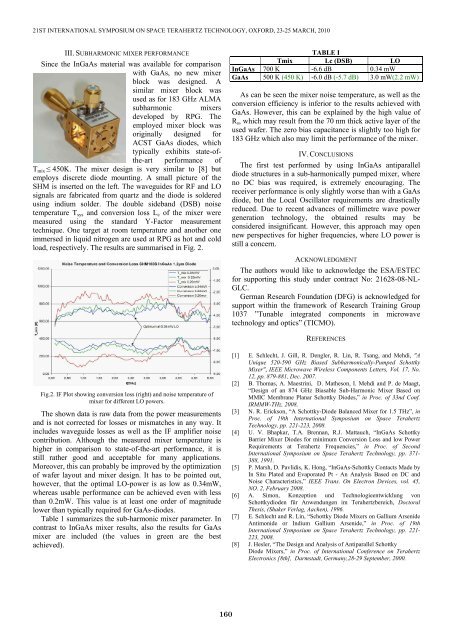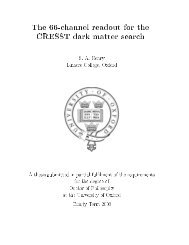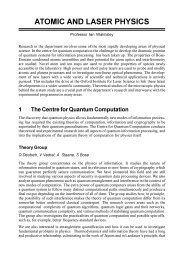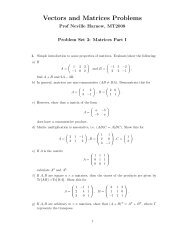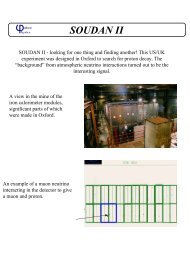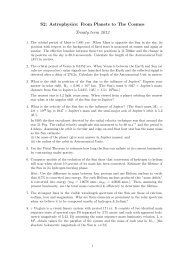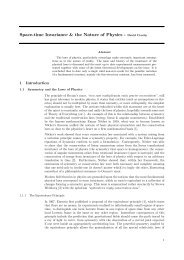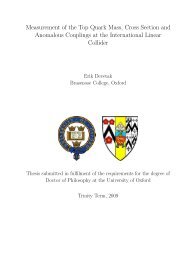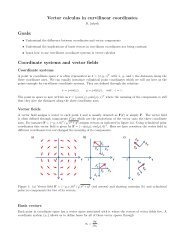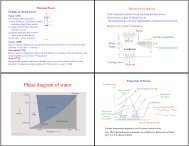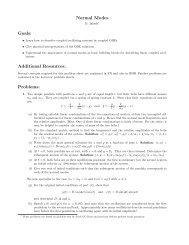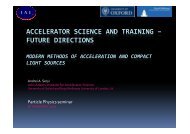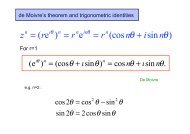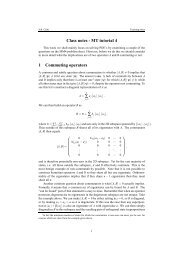Session S6: Schottky Diodes and Mixers - Department of Physics
Session S6: Schottky Diodes and Mixers - Department of Physics
Session S6: Schottky Diodes and Mixers - Department of Physics
You also want an ePaper? Increase the reach of your titles
YUMPU automatically turns print PDFs into web optimized ePapers that Google loves.
21ST INTERNATIONAL SYMPOSIUM ON SPACE TERAHERTZ TECHNOLOGY, OXFORD, 23-25 MARCH, 2010<br />
III. SUBHARMONIC MIXER PERFORMANCE<br />
Since the InGaAs material was available for comparison<br />
with GaAs, no new mixer<br />
block was designed. A<br />
similar mixer block was<br />
used as for 183 GHz ALMA<br />
subharmonic mixers<br />
developed by RPG. The<br />
employed mixer block was<br />
originally designed for<br />
ACST GaAs diodes, which<br />
typically exhibits state-<strong>of</strong>the-art<br />
performance <strong>of</strong><br />
T mix 450K. The mixer design is very similar to [8] but<br />
employs discrete diode mounting. A small picture <strong>of</strong> the<br />
SHM is inserted on the left. The waveguides for RF <strong>and</strong> LO<br />
signals are fabricated from quartz <strong>and</strong> the diode is soldered<br />
using indium solder. The double sideb<strong>and</strong> (DSB) noise<br />
temperature T sys <strong>and</strong> conversion loss L c <strong>of</strong> the mixer were<br />
measured using the st<strong>and</strong>ard Y-Factor measurement<br />
technique. One target at room temperature <strong>and</strong> another one<br />
immersed in liquid nitrogen are used at RPG as hot <strong>and</strong> cold<br />
load, respectively. The results are summarised in Fig. 2.<br />
TABLE I<br />
Tmix Lc (DSB) LO<br />
InGaAs 700 K -6.6 dB 0.34 mW<br />
GaAs 500 K (450 K) -6.0 dB (-5.7 dB) 3.0 mW(2.2 mW)<br />
As can be seen the mixer noise temperature, as well as the<br />
conversion efficiency is inferior to the results achieved with<br />
GaAs. However, this can be explained by the high value <strong>of</strong><br />
R s , which may result from the 70 nm thick active layer <strong>of</strong> the<br />
used wafer. The zero bias capacitance is slightly too high for<br />
183 GHz which also may limit the performance <strong>of</strong> the mixer.<br />
IV. CONCLUSIONS<br />
The first test performed by using InGaAs antiparallel<br />
diode structures in a sub-harmonically pumped mixer, where<br />
no DC bias was required, is extremely encouraging. The<br />
receiver performance is only slightly worse than with a GaAs<br />
diode, but the Local Oscillator requirements are drastically<br />
reduced. Due to recent advances <strong>of</strong> millimetre wave power<br />
generation technology, the obtained results may be<br />
considered insignificant. However, this approach may open<br />
new perspectives for higher frequencies, where LO power is<br />
still a concern.<br />
ACKNOWLEDGMENT<br />
The authors would like to acknowledge the ESA/ESTEC<br />
for supporting this study under contract No: 21628-08-NL-<br />
GLC.<br />
German Research Foundation (DFG) is acknowledged for<br />
support within the framework <strong>of</strong> Research Training Group<br />
1037 Tunable integrated components in microwave<br />
technology <strong>and</strong> optics (TICMO).<br />
REFERENCES<br />
Fig.2. IF Plot showing conversion loss (right) <strong>and</strong> noise temperature <strong>of</strong><br />
mixer for different LO powers.<br />
The shown data is raw data from the power measurements<br />
<strong>and</strong> is not corrected for losses or mismatches in any way. It<br />
includes waveguide losses as well as the IF amplifier noise<br />
contribution. Although the measured mixer temperature is<br />
higher in comparison to state-<strong>of</strong>-the-art performance, it is<br />
still rather good <strong>and</strong> acceptable for many applications.<br />
Moreover, this can probably be improved by the optimization<br />
<strong>of</strong> wafer layout <strong>and</strong> mixer design. It has to be pointed out,<br />
however, that the optimal LO-power is as low as 0.34mW,<br />
whereas usable performance can be achieved even with less<br />
than 0.2mW. This value is at least one order <strong>of</strong> magnitude<br />
lower than typically required for GaAs-diodes.<br />
Table 1 summarizes the sub-harmonic mixer parameter. In<br />
contrast to InGaAs mixer results, also the results for GaAs<br />
mixer are included (the values in green are the best<br />
achieved).<br />
[1] E. Schlecht, J. Gill, R. Dengler, R. Lin, R. Tsang, <strong>and</strong> Mehdi, "A<br />
Unique 520-590 GHz Biased Subharmonically-Pumped <strong>Schottky</strong><br />
Mixer", IEEE Microwave Wireless Components Letters, Vol. 17, No.<br />
12, pp. 879-881, Dec. 2007.<br />
[2] B. Thomas, A. Maestrini, D. Matheson, I. Mehdi <strong>and</strong> P. de Maagt,<br />
Design <strong>of</strong> an 874 GHz Biasable Sub-Harmonic Mixer Based on<br />
MMIC Membrane Planar <strong>Schottky</strong> <strong>Diodes</strong>, in Proc. <strong>of</strong> 33nd Conf.<br />
IRMMW-THz, 2008.<br />
[3] N. R. Erickson, A <strong>Schottky</strong>-Diode Balanced Mixer for 1.5 THz, in<br />
Proc. <strong>of</strong> 19th International Symposium on Space Terahertz<br />
Technology, pp. 221-223, 2008.<br />
[4] U. V. Bhapkar, T.A. Brennan, R.J. Mattauch, InGaAs <strong>Schottky</strong><br />
Barrier Mixer <strong>Diodes</strong> for minimum Conversion Loss <strong>and</strong> low Power<br />
Requirements at Terahertz Frequencies, in Proc. <strong>of</strong> Second<br />
International Symposium on Space Terahertz Technology, pp. 371-<br />
388, 1991.<br />
[5] P. Marsh, D. Pavlidis, K. Hong, InGaAs-<strong>Schottky</strong> Contacts Made by<br />
In Situ Plated <strong>and</strong> Evaporated Pt - An Analysis Based on DC <strong>and</strong><br />
Noise Characteristics, IEEE Trans. On Electron Devices, vol. 45,<br />
NO. 2, February 2008.<br />
[6] A. Simon, Konzeption und Technologieentwicklung von<br />
<strong>Schottky</strong>dioden für Anwendungen im Terahertzbereich, Doctoral<br />
Thesis, (Shaker Verlag, Aachen), 1996.<br />
[7] E. Schlecht <strong>and</strong> R. Lin, <strong>Schottky</strong> Diode <strong>Mixers</strong> on Gallium Arsenide<br />
Antimonide or Indium Gallium Arsenide, in Proc. <strong>of</strong> 19th<br />
International Symposium on Space Terahertz Technology, pp. 221-<br />
223, 2008.<br />
[8] J. Hesler, The Design <strong>and</strong> Analysis <strong>of</strong> Antiparallel <strong>Schottky</strong><br />
Diode <strong>Mixers</strong>, in Proc. <strong>of</strong> International Conference on Terahertz<br />
Electronics [8th], Darmstadt, Germany,28-29 September, 2000.<br />
160


